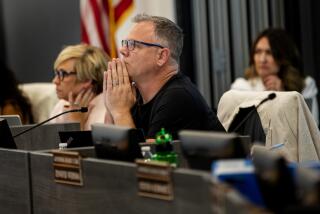Zeanah Foes Treading Where Few Have Gone
- Share via
THOUSAND OAKS — Rare is the recall drive that proceeds from the blustery talk of ouster to collecting signatures and making the ballot.
Rarer still is the recall drive that actually succeeds in blowing an elected leader out of office.
This fall, Councilwoman Elois Zeanah will be the first city leader in Thousand Oaks’ 33-year history to face a recall election, and one of the few in recent Ventura County history to endure what is widely considered one of the worst experiences in politics.
For whatever reason, recalls just don’t happen too often in Ventura County compared with other parts of California, according to Bruce Bradley, the county elections chief. He sees that as a good thing.
“When people ask me about Ventura County politics, it always strikes me that there’s a lack of recalls,” said Bradley, who has worked in the elections division since 1980. “We probably have had fewer recalls than any area I know. In Los Angeles and Orange counties, they recall people at the drop of a hat.”
But from Oxnard to Simi Valley, Thousand Oaks to Somis, recalls do occur. And the politicians who go through them are often left deeply scarred, even if they manage to survive, according to Oxnard Mayor Manuel Lopez.
Lopez would know. In 1984, he fought off a recall drive after voting for an unpopular utility tax. A fellow councilman, Tsujio Kato, met a harsher fate, probably because he was arrested for shoplifting $22 in barbecue utensils from an Oxnard Sears store just 20 months earlier.
“That’s the worst experience that I have gone through in 30 years of public life,” Lopez said. “It’s not something I would wish on anyone. You don’t know who your friends and your enemies are anymore. You’re fighting a phantom.”
The recall was a trying experience for the entire family, Lopez’s wife, Irma, said.
“From a family perspective, it was the most awful thing to go through,” she said. “Manny was not the only one to vote for that, and neither was Tsujio, but they only chose to go after them. I still remember waiting for the results that night. I felt really bad for Tsujio.” Recalls are so emotional and nasty, in fact, that even some political consultants think twice before getting involved.
*
“I’ve done one on each side, and I have no interest in ever doing one again,” said John Davies, who has worked on countless Ventura County campaigns. “It just brings out a lot of ugly people, and a lot of people that are good people turn ugly.”
Recalls in America originated in post-Revolutionary War times, but were removed from the books afterward and resurfaced in California and other states about the turn of the century, according to Mark Petracca, a political science professor at UC Irvine who has studied the recall process.
Terms for office were generally much shorter in the 1800s than today--often only a year--and many voters and political observers were concerned politicians spent too much time campaigning and not enough time tending to the affairs at hand.
Lawmakers decided to lengthen terms. But in doing so, they realized there had to be a mechanism to get rid of people who violated the public trust.
So they brought back the concept of recall, along with the initiative and referendum process.
There is a common misconception that recalls in California were only intended to remove those who had committed “malfeasance in office,” Petracca said. “You can try to recall someone in California because you don’t like the color of their hair or the fact that they smoke. You can make a moral argument, but there is no such thing as an inappropriate recall in this state.
“Recall is not an avenue to go after people who have committed crimes--there are better ways to do that,” he added. “The people who conceived recall knew that things were often more ambiguous. Of course, those people never imagined armies of paid petitioners like we have today.”
In the case of Zeanah, the committee Yes! Remove Elois Zeanah has spent more than $264,000 to oust her, according to campaign finance reports released last week. The amount represents an unheard-of sum for a local political race in Ventura County, and more than four times the largest sum ever spent on a Thousand Oaks council race.
*
Most of that money--$173,000--came from Moorpark businesswoman Jill Lederer, who owns a chain of Domino’s Pizza franchises in the Conejo and San Fernando valleys, according to the group’s treasurer, Linda L. Tucker.
With help from professional petitioners, Yes! Remove Elois Zeanah collected the necessary signatures for a recall election not once, but twice.
The signatures from the initial effort were frozen by a Ventura County Superior Court judge after Zeanah’s lawyers argued they were collected using petitions that violated state law. But the cash-flush committee simply went out and did it again.
Zeanah contends it is grossly unfair for one person--especially an out-of-towner--to invest so much to boot her from office, particularly considering that she is up for reelection next year anyway.
The way Zeanah sees it, Lederer, a former campaign manager for Councilman Andy Fox, is abusing the recall process because she knows Proposition 208, a statewide campaign contribution law, limits how much she can spend on a regular election.
The law, approved by voters last year, does not apply to recalls.
“This is an abuse of the political process,” Zeanah said. “It’s so undemocratic for out-of-town interests to buy an election like this.”
Peter J. Turpel, a spokesman for Yes! Remove Elois Zeanah, sees the situation differently. Zeanah, Turpel said, is such a disruptive influence on the City Council that she must be ousted now--and a group such as Yes! Remove Elois Zeanah has every right to try and do so.
“We know recalls are something to be taken very seriously,” Turpel said. “But if this is not a perfect example of someone that needs to be recalled, I don’t know what is. Elois Zeanah has cost this city thousands of dollars with her irresponsible decisions. She answers to no one.”
*
Former Mayor Alex Fiore, who served on the City Council from the city’s incorporation in 1964 until three years ago, also believes Zeanah should be recalled. Fiore, the subject of a recall drive himself just a few years ago, chipped in $100 to the campaign against her.
“The bottom line is, the woman is bad news,” Fiore said of his former nemesis. “She’s a demagogue. I’m tired of hearing her conspiracies about the good people on our city staff, and I think the public is too.”
For recall drives to be successful, they must usually meet at least two of three critical requirements, Petracca said.
They must center around a single, “lightning-rod” issue, have a large grass-roots network or extremely deep pockets with which to lead the charge, and target an individual who, for whatever reason, has generated a lot of ill will in the community.
In Simi Valley in 1979, voters gave Mayor Ginger Gherardi and Councilman William Carpenter the recall boot largely due to a single issue: increasing sewer fees in what opponents characterized as a money grab “violating the spirit of Prop. 13.”
But current Mayor Greg Stratton, elected to the council in a special election later that year, said sewer rates were never the real issue. He believes some people in the city’s business community simply thought the council was imposing too many restrictions.
“It was a struggle over growth, really,” Stratton said. “Although the council [raised sewer rates] unanimously, they didn’t go after the pro-growth people. . . . We’d had some real big battles between the homeowners and the business community.”
The council, however, did not change much philosophically, Stratton said. And he suspects the recall backers were disappointed by the outcome.
*
Stratton worked for Carpenter’s recall defense committee. But once Carpenter was ousted, he--like the other winner, Rep. Elton Gallegly (R-Simi Valley)--saw there was a good chance to win a seat on the council.
“If you’re going to run for office, that’s a great time,” he said. “There aren’t a lot of people running, and there are not as many people voting. I only spent about $1,000 on that race. Can you imagine doing that now?”
In Moorpark in 1987, residents voted by a 3-to-1 margin to recall Councilman Thomas C. “Bud” Ferguson, also stemming from a single incident: Former council colleague Danny Woolard, who was himself accused of accepting a bribe, accused Ferguson of buying his vote by loaning him about $30,000.
Although a six-month investigation by the district attorney’s office resulted in no charges against Ferguson, investigators concluded he had lied under oath and had a “sense of morality that is out of step with 20th-Century California politics.”
Ferguson, who stressed his innocence to the end, knew his goose was cooked. He barely fought the recall, and predicted his ouster in an interview with The Times before the election.
Likewise, after they raised water rates amid the drought and struggling economic times of 1991, Camrosa Water District board President Jack C. Rogers and members William Goth and Kenneth P. Gerry were recalled by Santa Rosa Valley voters.
And after the school board fired popular Supt. Dale Forgey in 1992, so were three members of the tiny Somis Union Elementary School District board: Debbie Carpenter, Miguel Mejia and Alda Perry.
But focusing on one emotional issue is not always enough to recall someone.
For instance, a Thousand Oaks group that labored for years to oust Fiore and then-Councilman Frank Schillo over their approval of the Civic Arts Plaza failed several times to gather enough signatures to force an election.
The problem, said Bradley of the county elections division, is that while many were angry about the decision to build the monolithic City Hall and performing arts center, many others agreed with it. The community was too divided to swing the pendulum in either direction, Bradley said.
He sees parallels between that recall fight and Zeanah’s.
“Every recall issue I’ve seen in Thousand Oaks is like that, including the Zeanah recall,” Bradley said. “It seems that a good percentage of the people are voting for these folks, so they represent a large share of the people.”
Stratton of Simi Valley agreed.
“I don’t know that Thousand Oaks will see much change,” he said. “The two sides seem so split that neither can deliver a knockout blow.”
Whether Zeanah will be knocked out in November remains to be seen. But political consultant Davies said one thing is certain: She is unlikely to come out of the experience in better political shape than before.
“The biggest thing I’ve learned if you’re fighting recall is that you may win, but you are hardly ever strengthened,” Davies said. “Most [political leaders] I’ve known were so mortally wounded that when people had another choice, they took it.”
More to Read
Sign up for Essential California
The most important California stories and recommendations in your inbox every morning.
You may occasionally receive promotional content from the Los Angeles Times.










